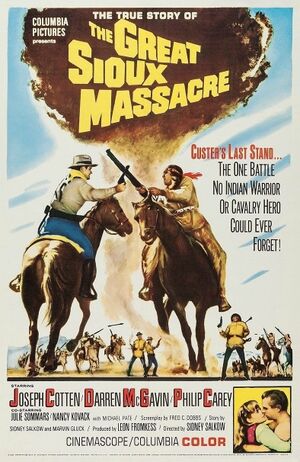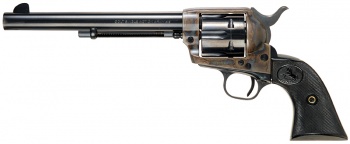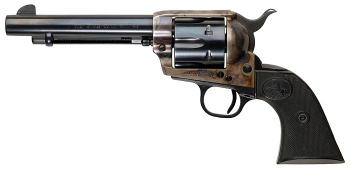| If you have been locked out of your account you can request a password reset here. |
Difference between revisions of "The Great Sioux Massacre"
Doctor Luika (talk | contribs) |
|||
| Line 30: | Line 30: | ||
[[File:T.G.S.M Colt SAA-3.jpeg|thumb|none|600px|Major Reno orders Benton to shoot and kill the Indians, but the latter opposes the order while holding his Colt Single Action Army.]] | [[File:T.G.S.M Colt SAA-3.jpeg|thumb|none|600px|Major Reno orders Benton to shoot and kill the Indians, but the latter opposes the order while holding his Colt Single Action Army.]] | ||
[[File:T.G.S.M Colt SAA-5.jpeg|thumb|none|600px|After the Indians spare his life and escort him to an unknown location, their soldiers save Benton just in time.]] | [[File:T.G.S.M Colt SAA-5.jpeg|thumb|none|600px|After the Indians spare his life and escort him to an unknown location, their soldiers save Benton just in time.]] | ||
| − | [[File:T.G.S.M Colt SAA-7.jpeg|thumb|none|600px|Custer and his brother are surrounded by Indians, Custer tries to convince his brother to retreat, but the latter stays to fight to the death. While often depicted using a SAA in popular culture, Custer actually carried a pair of . | + | [[File:T.G.S.M Colt SAA-7.jpeg|thumb|none|600px|Custer and his brother are surrounded by Indians, Custer tries to convince his brother to retreat, but the latter stays to fight to the death. While often depicted using a SAA in popular culture, Custer actually carried at least 1, if not a pair of .442 caliber [[Webley RIC]] revolvers as his preferred sidearms.]] |
[[File:T.G.S.M Colt SAA-8.jpeg|thumb|none|600px|One of the soldiers protecting Lieutenant Colonel Custer is hit by an arrow and brandishes his Colt Single Action Army before collapsing.]] | [[File:T.G.S.M Colt SAA-8.jpeg|thumb|none|600px|One of the soldiers protecting Lieutenant Colonel Custer is hit by an arrow and brandishes his Colt Single Action Army before collapsing.]] | ||
[[File:ColtSingleActionArmy.jpg|thumb|none|350px|Colt 1873 Single Action Army w/ 5.5" barrel - .45 Long Colt]] | [[File:ColtSingleActionArmy.jpg|thumb|none|350px|Colt 1873 Single Action Army w/ 5.5" barrel - .45 Long Colt]] | ||
Latest revision as of 00:12, 17 September 2024
| ||||||||||||||||||||||||||
The Great Sioux Massacre is a 1965 American Western film directed by Sidney Salkow and starring Darren McGavin, Joseph Cotten, and Philip Carey. The film revolves around Custer's Last Stand through the eyes of one of his subordinates. The film is a remake of Salkow's 1954 movie Sitting Bull, with some stock footage from that movie appearing in the film.
The following weapons were used in the film The Great Sioux Massacre:
Revolvers
Colt Single Action Army
Captain Benton (Darren McGavin), Lieutenant Colonel Custer (Philip Carey), Major Reno (Joseph Cotten), and virtually the entire 7th Cavalry are armed with the Colt Single Action Army. Although they are mostly 7.5" barrel models, Dakota (John Matthews) briefly carries a 5.5" barrel model. 7.5" barrel Single Action Army revolvers were the standard sidearm of US Cavalry forces at the time, issued alongside a Springfield Trapdoor Carbine. The 7th Cavalry at Little Bighorn were issued 24 rounds for their revolvers.

Rifles
Winchester Model 1892
Both US Army soldiers and Native Americans carry Winchester Model 1892 to fight and slaughter each other. Dakota (John Matthews) briefly uses a Winchester Model 1892 at the beginning of the film. This is an anachronism considering the film is based in 1876 and the Winchester Model 1892 was introduced 16 years later. Many of the Native American combatants were armed with a wide array of repeating rifles, from the older Henry 1860 or Winchester Model 1866 to Winchester Model 1873s, one of the most sophisticated small arms in North America at the time.
Springfield Model 1873 Trapdoor Carbine
True to life, soldiers of the 7th United States Cavalry carry the Springfield Model 1873 Carbine as their service rifles. Native Americans also carry Springfield Model 1873 Carbines to fight against the US Army.

M1903 Springfield
What appear to be M1903 Springfield rifles are carried by the last soldiers protecting Lieutenant Colonel Custer (Philip Carey) from the natives in the climactic battle of the film. This is an anachronism since the film is set in 1876 and the M1903 Springfield was introduced 27 years later.





















